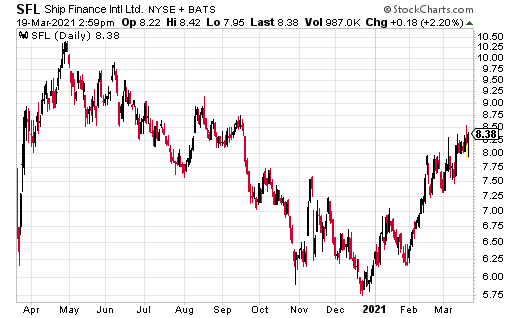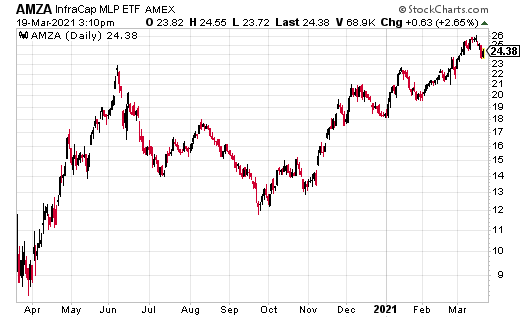

– Tim Plaehn, Editor, The Dividend Hunter
![]()
 My name is Tim Plaehn, I am a former F-16 Airforce pilot, mathematician, and certified financial planner. That’s me on the right in my Airforce days. Today, I make a living investing in the stock market with the goal of building a stable and growing dividend income stream that I can live off of.
My name is Tim Plaehn, I am a former F-16 Airforce pilot, mathematician, and certified financial planner. That’s me on the right in my Airforce days. Today, I make a living investing in the stock market with the goal of building a stable and growing dividend income stream that I can live off of.
Why Dividend Stocks?
It is very difficult, if not impossible, to predict the direction of share prices. Most market direction forecasts are only useful for the short to intermediate term. That’s why I have developed stock buying, selling, and tracking strategies that help me towards the goal of a large and growing dividend income stream.
I never worry about the day to day movements of the stock market because I have developed tools and systems (which I am happy to share with you) that allow me to know exactly how much I earn every month from my income stocks and how much I will earn in the next 12 months. I call this system the Monthly Dividend Paycheck Calendar, and I’ll explain more on that later.
I like dividends because they give you returns in the form of cash payments into your brokerage account. To think of it one way, it’s like having a neighbor that comes to your house every couple of months and puts a couple crisp hundred dollar bills right into your pocket.
My goal is to fill my neighborhood with fine ladies and gentleman like that, who bring me payments every month. Dividends are always paid in cash and you can decide to do whatever you want with that money.
With other types of stocks, it might feel great to have the price go up 20% in a year, but you won’t see any of that money unless you sell the shares. With dividend stocks, you earn cash returns like clockwork. This gives a consistency to your stock returns that cannot be matched by investments that do not pay dividends.
However, there can be a lot of misleading information out there on the internet. I for one am not a huge fan of the huge “investortainment” media sites and cable news shows as they tend to spread opinions as if they were facts. I prefer to stick to facts. That’s why I’ve released this report for free to the public (I usually charge $49 for this specific information). I want you to have information and analysis that actually packs a punch so you can make confident investing decisions.
Two Strategies for Earning High-Yield Dividend Income
Reading this report won’t make you an expert income investor overnight (A subscription to my Dividend Hunter newsletter might!), but it will lay a foundation that you will be able to build off.
With that in mind, here are a few strategies I use that may be out of step with what you have learned from the entertainment-focused financial news outlets and my the dividend stock that pays an 18% yield like clockwork.
Track your dividend earnings on a monthly or quarterly basis. The online brokerage account systems do a terrible job of tracking stock returns including dividends. For example — and this is only an example, not necessarily a current stock recommendation — I have accumulated shares of Ship Finance International Limited (NYSE: SFL) in one of my accounts. The brokerage account summary page shows the shares are up about 2.5%.

Yet with dividends included, the SFL shares have earned a 17% total return since I started buying into the stock. To know that information, I have kept a spreadsheet that lists each dividend stock I own, and the individual listings are updated with each share purchase and dividend earned.
Be willing to buy more shares of your income stock investments when the share price drops. This is a hard one for investors to do, but it will make a huge difference over years of investing. Again, using SFL as an example, my first purchase was at $16.07 per share. The current share price is below that point, yet I am in a positive share value position in the stock.
That is because over the last two years I have made nine additional purchases at share prices ranging from $12.96 to $15.20. When there is a significant short-term drop in the stock price, I look to buy more. I also think about buying after a stock goes ex-dividend. Typically, the share price will drop by several percentage points as the “dividend capture” crowd rushes to sell after locking in the receipt of the dividend payment.
When you have cash available to invest, there is probably a stock or two in your portfolio, or on your stock wish list, that has dropped from recent highs. These are the shares you want to think about buying and then consider which one fits into your overall portfolio strategy.
I have one or two stocks that I think of as “junk drawer” stocks. These are the very high-yield stocks that I can buy shares in when I find some extra cash in my brokerage account. Think of these stocks as a place where you can put some cash to work after you sell shares of one of your income stocks that have run up to a high price.
Yes, I like to take profits (usually a partial sale) if one of my income stocks is showing big gains compared to what I paid for the shares. Your junk drawer stock is also a place to put the proceeds back to work after one of your stocks unexpectedly cuts its dividend and you have to close out the position at a loss. It can happen to any of us.
The Dividend Stock that Pays an 18% Yield Like Clockwork
Your junk drawer stock needs to be one that pays a high yield and one where you have confidence in the underlying company value. In practice, this stock can turn extra cash into significant extra dividend income. Here is an 18% yielder from my newsletter, The Dividend Hunter, recommendations list that I use as a stock to put extra cash to work to earn big dividends over time.
Ultra-high-yield ETF, InfraCap MLP ETF (NYSE: AMZA) has been a great income investment for my Dividend Hunter newsletter subscribers. New subscribers typically ask how this fund can pay dividends to support the 18% yield, and is there a risk of a dividend cut?

In fact, and to many new subscribers’ surprise, the share price and dividend payments from AMZA have surprisingly stable support.
AMZA was the first actively managed ETF in the energy infrastructure MLP sector. Actively managed means that the fund managers have discretion to not exactly track a specified stock index. AMZA owns the same MLPs that are the components of the Alerian MLP Infrastructure Index (AMZI).
This index tracks the largest, most stable infrastructure services providing MLPs and is market cap weighted, which means the share values of the largest MLPs have more effect on the index value. With its active management charter, the AMZA managers overweight or underweight the different MLPs based on their analysis of the investment prospects for the individual MLP companies. The ability to overweight higher yield MLPs plus the moderate amount of leverage allowed by the fund’s charter results in a portfolio yield that is several percent higher than the current AMZI yield of 6.75%.
The AMZA charter also allows the managers to sell call options against the portfolio stocks. The use of a covered call strategy provides the additional cash flow AMZA needs to support the dividend. Since its Fall of 2014 IPO, these cash flow generation strategies have worked for AMZA. The fund launch was just before the energy sector entered a severe, yearlong bear market. The AMZA share price fell right along with the rest of the MLP sector, but the fund continued to pay the large dividend without interruption.
I regularly communicate with the AMZA fund management team. They believe the current dividend rate is sustainable, barring any serious disruption to the energy infrastructure space. For the rest of 2017, I expect just the opposite.
This should be a very good year for MLP investments. Both distribution rates and share prices should rise over the course of the year. As MLPs on average increase the distributions paid to investors, it will become easier for the AMZA management to make sure the dividend is covered.
I do strongly recommend that investors who own AMZA reinvest at least a portion of those large dividend payments back into more shares. Taking just one-quarter of the dividend payment to buy additional AMZA shares would leave an investor with 13.5% in fee cash flow and also grow future dividend payments by about one percent each quarter. That’s a win-win scenario that is very hard to beat!
I have strict requirements that every high-yield stock must meet before I recommend it to my Dividend Hunter newsletter subscribers and the general public. Every high-yield stock that I recommend must have a high potential for dividend growth and a huge margin of safety in their cash flows.
Finding these high-yield stocks with growing dividends and safe payments requires a lot of research, but, after it all, my subscribers and I regularly collect big dividend payments that give us financial certainty in an uncertain world.
In my Dividend Hunter newsletter, I recommend the market’s strongest, most stable high-yield dividend payers, and there are over 20 high-yield stocks currently available through my Monthly Dividend Paycheck Calendar, a system for generating a recurring monthly income stream using my Dividend Hunter recommendations.
